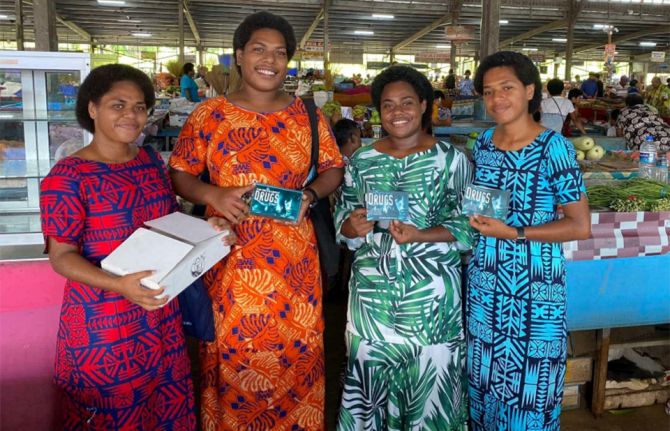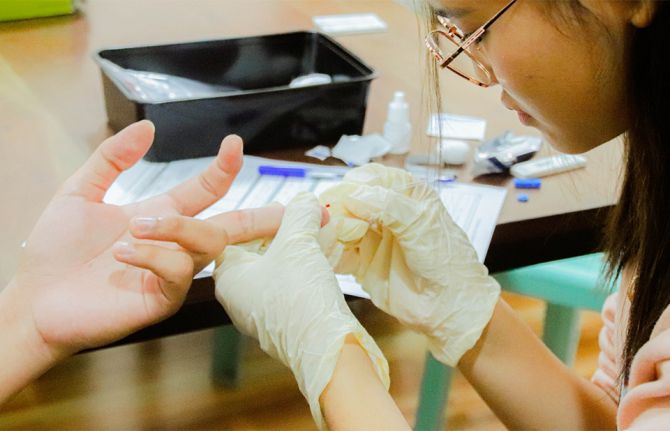
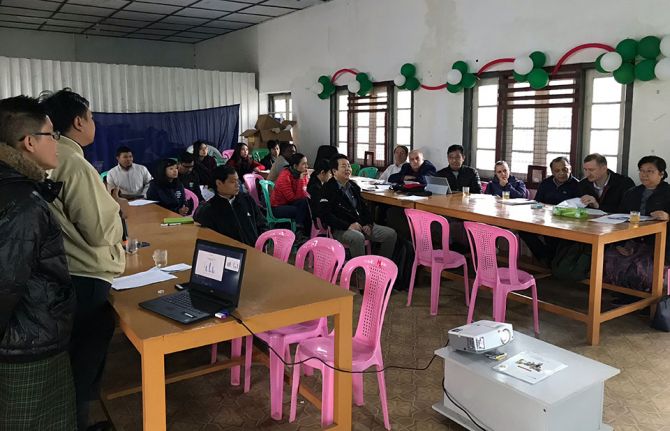
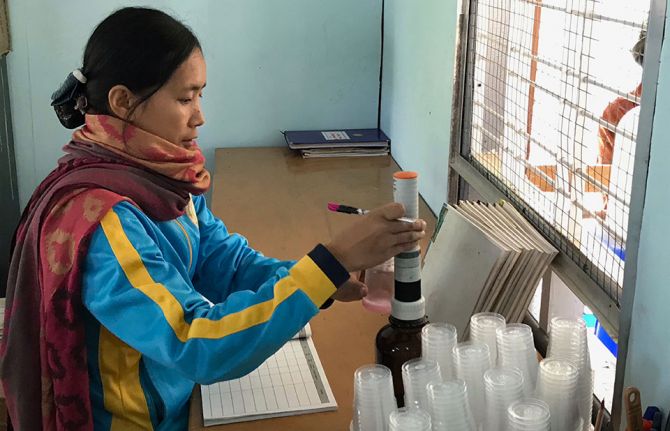
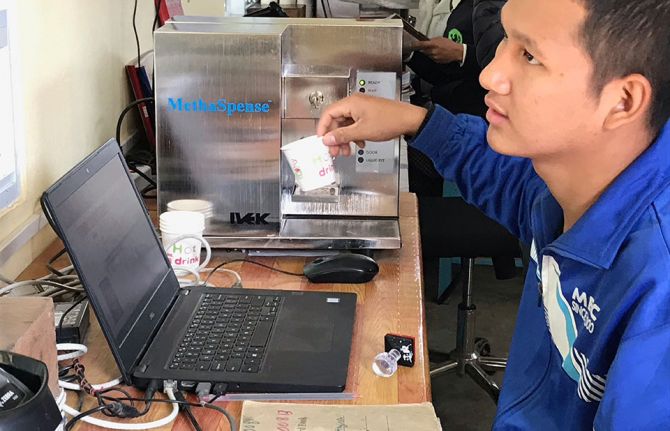
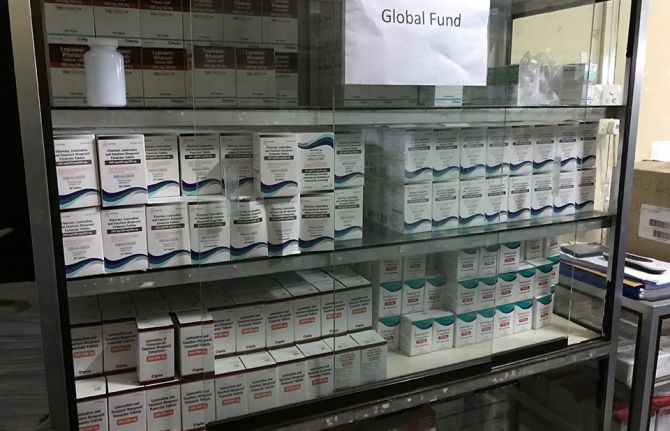
Feature Story
Mining, drugs and conflict are stretching the AIDS response in northern Myanmar
23 March 2020
23 March 2020 23 March 2020“People who inject drugs can access harm reduction services and HIV treatment, but they still don’t go for them. Why?” asked Deputy Director-General of Communicable Diseases of the Myanmar Ministry of Health and Sports, Thandar Lwin, while searching for ways to respond to the drug-related HIV epidemic in northern Myanmar.
One of the most affected regions is the northern most state of Kachin, where, according to government statistics, 72% of new HIV infections occur among people who inject drugs.
Bordering China on the east and India on the west, Kachin State reports the highest prevalence of HIV in the country, at 2.8%—the national HIV prevalence is estimated at 0.57%. The state is home to only 3% of the country’s population, but to 23% of all the people who inject drugs in Myanmar, whose HIV prevalence is more than 40%.
The reasons for such a concentrated epidemic among people who use drugs are varied. Mining, particularly for jade, illicit drug cultivation, production and trafficking, limited education and access to health services, and armed conflict are some of the obstacles to an effective response to the epidemic in the area.
Heroin and methamphetamine are widely available in towns and rural areas. The drugs are used by those who work long hours in mines and plantations, or for recreational purposes by children as young as 14 years, who can inject several times a day.
In response, the government is providing HIV and harm reduction services at its health facilities and through a network of satellite clinics and drop-in centres run by nongovernmental organizations working with community health volunteers. Together, they provide, or refer people to, a wide range of services, including peer counselling, testing and treatment, needle–syringe programmes, opioid substitution therapy, condoms and treatment of sexually transmitted infections.
However, even with a government willing to support harm reduction services, the magnitude of the drug use problem is stretching capacity. Although there is political will, and financial resources are available, there is an urgent need to better understand the reasons why services are not always reaching the people who need them the most.
For that reason, a delegation led by the Government of Myanmar and the Global Fund to Fight AIDS, Tuberculosis and Malaria (Global Fund)—the biggest funder of the AIDS response in the country—together with the technical partners, UNAIDS and the World Health Organization, and the principal recipients, the United Nations Office for Project Services and Save the Children, visited the area to see how programmes are being implemented and to find alternative ways to effectively deliver services.
“Programming in this context requires partnership, collaboration and innovative approaches to ensure that the investments and activities have an impact in such a demanding environment,” said Izaskun Gaviria, Senior Fund Portfolio Manager at the Global Fund.
The visit showed that a good multipartner national response to HIV is producing results in parts of the country, but is falling short in areas affected by poverty and because of the availability of cheap drugs, a mobile population following seasonal work and long-standing ethnic conflicts. It also showed that policy changes are urgently required in order to improve access to opioid substitution therapy, antiretroviral therapy and other health services, including needles and syringes and naloxone for overdose management.
Fifty-nine per cent of people who use drugs in Myanmar were tested for HIV in 2016, rising to 74% in 2018. However, there is a gap between the number of people who test positive for HIV and the number of people who start on antiretroviral therapy. Many of the people either not initiating treatment or stopping are mobile seasonal workers, who come from within and beyond Kachin State.
The need for confirmatory HIV tests to be made at public health centres and the fact that people must have several mandatory counselling sessions before treatment can be initiated may also be contributing to the high percentage of people who test positive but are not yet accessing treatment. The Ministry of Health and Sports has issued a directive stating that all designated public sector services can initiate antiretroviral therapy. However, more reforms are required to bring health care to people who use drugs, who face legal challenges and, often, hostility in local communities.
The government has for a long time demonstrated a genuine interest in providing harm reduction services to people who inject drugs. Sterile needles and syringes can be obtained from health services run by nongovernmental organizations and rural drop-in centres, and some villages even have needle–syringe dispensers. However, the two syringes per user per day falls short of the actual daily injection average, and the needles and syringes are not distributed proportionally where the people who inject drugs live.
Furthermore, the fact that only public health facilities are authorized to provide opioid substitution therapy is hindering efforts to reach out to the people who need it. Transportation costs and remoteness are other obstacles to people who use drugs accessing their daily dose of methadone. Even the take-home dose, which the government is piloting among qualifying users, requires people to travel long distances to access it.
Perhaps the biggest challenge, however, remains the stigma and discrimination faced by people who use drugs and the resistance to harm reduction, especially needle–syringe programmes, at the local level from law enforcement agencies and faith-based antinarcotic drug groups in Kachin State. A lack of understanding of the concept of harm reduction, including the mistaken belief that the distribution of needles and syringes encourages drug use, is at the root of the stigma and discrimination. Police crackdowns and anti-drug operations by faith-based organizations contribute to driving people who inject drugs underground, away from harm reduction services.
The visit also brought to light an increasing hepatitis C epidemic among people who inject drugs. Testing for hepatitis C has revealed an estimated prevalence as high as 80% in at least one township among people who inject drugs. But despite this staggering percentage, there is currently no widescale hepatitis C treatment available. This, however, is something that the Global Fund is now considering to include in the next grant cycle following discussions with health officials and partners, together with an improved needle–syringe programme, the use of buprenorphine as an alternative to methadone and the introduction of pre-exposure prophylaxis. The United States President’s Emergency Plan for AIDS Relief is also contributing to funds for some of these innovations. But perhaps one of the most urgent improvements required is the creation of a unique code identifier, with sufficient safeguards for confidentiality, in order to provide patients with the treatment and services they need no matter where they are in the country.
Overall, and despite the many challenges, Myanmar is showing steady progress in its response to HIV thanks to a well-coordinated multipartner response. An extensive investment of resources by the Global Fund and other donors, as well as an increase in domestic funding, has led to a substantial scale-up of services across the country, which has resulted, according to the government, in the number of new HIV infections dropping by 31% from 2010 to 2018. Eighty per cent of people living with HIV in Myanmar know their status and the percentage of people living with HIV who have access to antiretroviral therapy rose from 1% in 2005 to 70% in 2018.
Nonetheless, the capacity of the government and nongovernmental organizations to deliver services seems to be reaching its limits. According to the UNAIDS Country Director, Oussama Tawil, “Key elements to expand the provision of services would include allowing task-shifting towards primary health-care providers, community health volunteers and the wider local community, improving linkages and integration of public and nongovernmental organization services and investing in human resources.”
The situation in Kachin State as well as other neighbouring states with similar characteristics, such as Shan North and Sagaing, has shown that there is an urgent need to adapt the AIDS response to specific locations and populations, but also that socioeconomic contexts have to be addressed for public health approaches to succeed. “Unless we address the underlying family livelihood issues and wider health consequences, and adapt to the local realities related to mining, economic interests and drug use, existing services won’t be enough,” said Mr Tawil.

